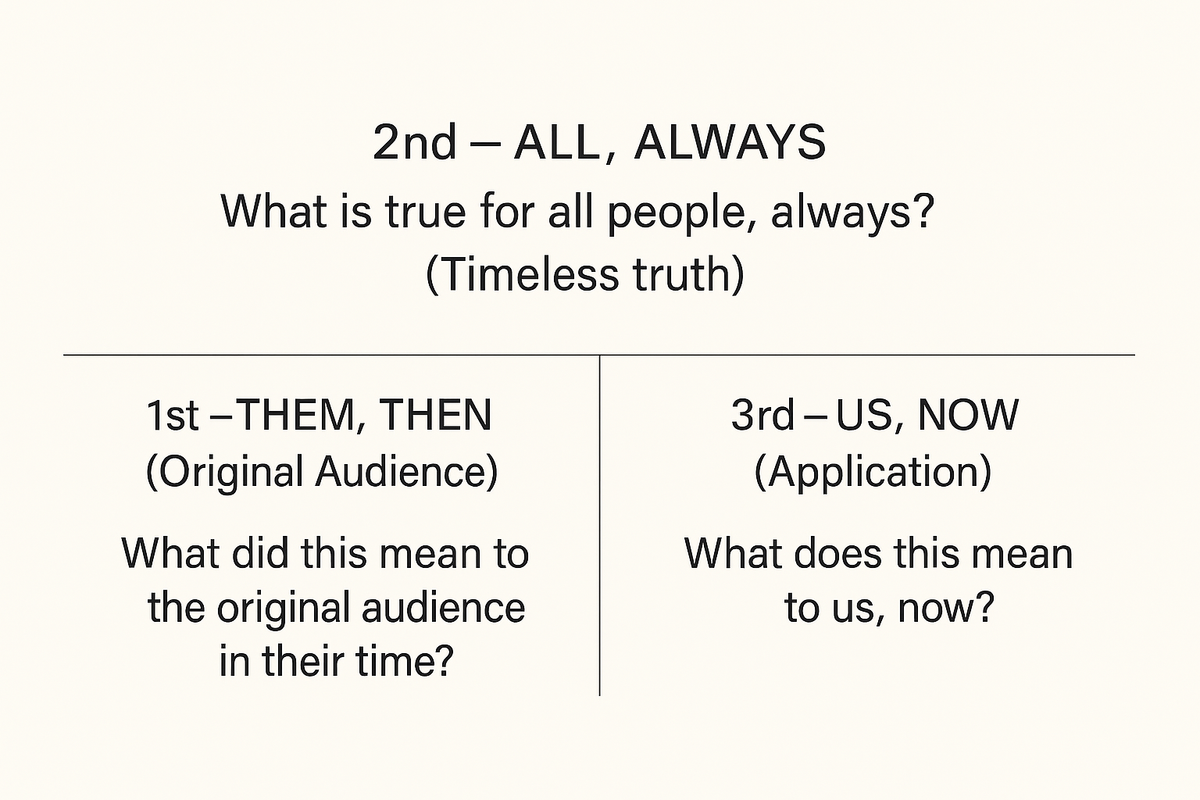Post 6 – How to Read the Old Testament Like Jesus

This post is the final part of the series:
"Why We Need the Old Testament—Now More Than Ever"
View the full series here →
Post 7 – How to Read the Old Testament Like Jesus
When Jesus read the Old Testament, he didn’t treat it as a historical relic or a discarded lawbook. He saw it as living testimony—pointing to himself, revealing God’s heart, and shaping the imagination of God’s people.
But many modern Christians are unsure what to do with the Old Testament. Some avoid it. Others misuse it. Some interpret it through distorted frameworks that don’t honor the original authors—or the fulfillment Jesus brings.
To read the Bible like Jesus did, we need to develop the same posture: faithful, expectant, and Christ-centered.
How to Read the Old Testament Using the Interpretive “T” Chart
To read the Bible faithfully—especially the Old Testament—we must bridge the cultural, historical, and theological distance between them, then and us, now. A helpful tool is the Interpretive T Chart. It invites us to ask three questions:

| 1st – THEM, THEN | 2nd – ALL, ALWAYS | 3rd – US, NOW |
|---|---|---|
| What did this mean to the original audience in their time? | What timeless truth does this reveal about God, humanity, or the world? | How do we live this truth today in light of Jesus and the Spirit? |
Why This Matters
Many modern approaches—particularly forms of Dispensationalism—often skip the first two steps, especially in apocalyptic books like Daniel or Revelation. They pull symbols out of historical context—a beast here, a temple there—and link them to current events.
But Revelation wasn’t written for predictions—it was written to encourage persecuted Christians to remain faithful. It’s pastoral, not just prophetic.
When we ignore historical context and symbolic genre, we don’t just get Scripture wrong—we miss its real power.
How Jesus Read the Old Testament
Jesus didn’t erase the Law or the Prophets. He fulfilled them (Matt. 5:17). That means the Old Testament remains essential—but must be read through the lens of Christ’s fulfillment.
When tempted, Jesus quoted Deuteronomy. When teaching in the synagogue, he read Isaiah. After the resurrection, he walked two disciples through the Law, Prophets, and Writings to show how they pointed to him (Luke 24:27).
The point isn’t to mimic ancient rituals—but to see how they pointed to Jesus and how his fulfillment reshapes our lives now.
Example: The Sabbath
THEM, THEN
To Israel, the Sabbath was a sign of liberation—a reminder that they were no longer slaves in Egypt.
ALL, ALWAYS
God designed human life for rhythm: work and rest, dependence and delight.
US, NOW
Jesus invites us into deeper Sabbath—not just a day, but a life of rest in him. Yet the principle of rhythm, worship, and trust still matters.
Live Sent Practice
Pick one Old Testament passage (e.g., a command or prophetic vision) and walk it through the Interpretive T:
- What did this mean to them, then?
- What timeless truth applies to all, always?
- How should we live this now, through Jesus?
Try this with Exodus 20:8–11, Amos 5, or Psalm 1.
Other Posts in This Series
- Post 1 – Why the Old Testament Still Matters
- Post 2 – Jesus and the Law: Fulfillment, Not Cancellation
- Post 3 – Types and Shadows: Finding Christ in the Old Testament
- Post 4 – Prophets, Justice, and the Mission of God
- Post 5 - Justice, Mercy, and the Prophets
- Post 6 - How to Read the Old Testament Like Jesus
